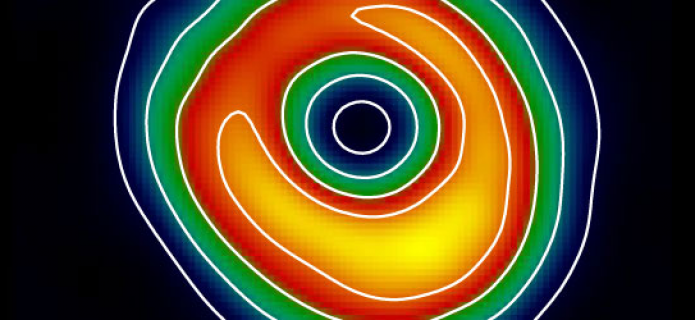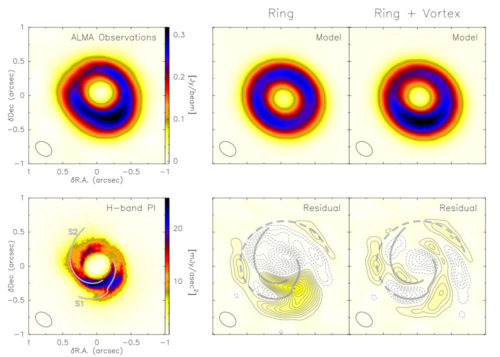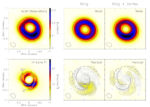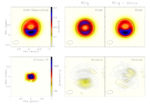Protoplanetary Disks ‘Bulge’ in Complex and Asymmetrical Ways
Astronomers using the Atacama Large Millimeter/submillimeter Array (ALMA) have studied two massive protoplanetary disks and discovered large-scale asymmetries in the way their dust is distributed.
By comparing these results with other early ALMA observations, the researchers speculate that asymmetrical disks may be the norm and an essential step along the path to planet formation.
In these protoplanetary systems, dubbed SR 21 and SAO 206462, ALMA revealed dust-depleted disk cavities near the stars and gaseous disks extending farther into space. It was in these extended gaseous regions that the asymmetries in the dust were discovered.
"These observations revealed large-scale asymmetries in the outer portions of the disks, each containing as much material as two Jupiter-sized planets," said Chilean astronomer Laura Perez with the National Radio Astronomy Observatory (NRAO) in Socorro, New Mexico. "The best fit to explain these observations is a vortex structure in the outer disk."
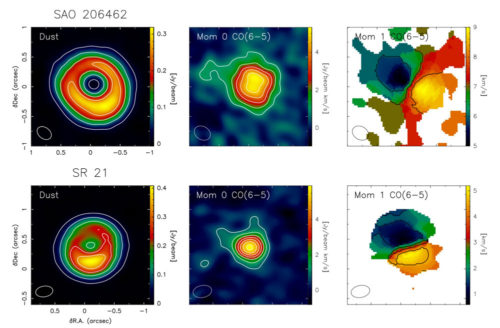
Credit: L. Perez (NRAO/AUI/NSF); B. Saxton (NRAO/AUI/NSF); T. Muto (Kogakuin University); NAOJ/Subaru
Similar in some respects to other asymmetrical bulges known as "dust traps" seen in earlier ALMA observations, these vortices could help the dust and gas around stars to clump together more readily. Models predict that once dust grains achieve a certain size, they either would drift inward toward the star or collide with other similar-size grains. By concentrating dust and gas, these asymmetrical regions may provide a safe haven where grain growth can continue.
The vortices revealed in the new ALMA observations occupy a much wider swath of the disk than seen in previous observations, however. This may indicate that they formed under different conditions, possibly as the result of turbulence in the disk.
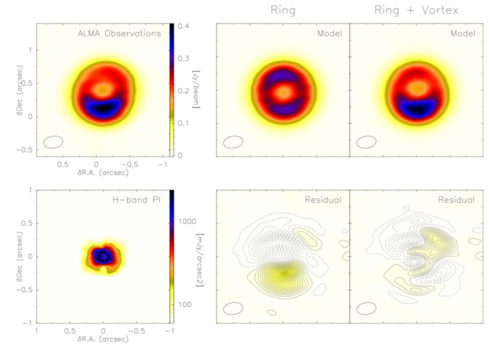
Credit: L. Perez (NRAO/AUI/NSF); B. Saxton (NRAO/AUI/NSF); K. Follette (Univ. Arizona); NAOJ/Subaru
Both SR 21 and SAO 206462 are in the process of transforming from optically thick disks brimming with dust and gas to optically thin debris disks, potentially harboring fully formed planets. Earlier observations with other telescopes failed to detect these large asymmetrical regions. ALMA’s enhanced resolution and sensitivity, however, could discern these features.
Perez and her colleagues speculate the process (or processes) that creates these asymmetries may be taking place in most transitional disks.
ALMA also detected residual structures that don’t quite fit into the vortex model. It’s possible these represent spiral structures in the disks, but future observations with ALMA and the Karl G. Jansky Very Large Array (VLA) are necessary to confirm this.
The results are published in Astrophysical Journal Letters. https://arxiv.org/abs/1402.0832
More Information
The Atacama Large Millimeter/submillimeter Array (ALMA), an international astronomy facility, is a partnership of the European Organisation for Astronomical Research in the Southern Hemisphere (ESO), the U.S. National Science Foundation (NSF) and the National Institutes of Natural Sciences (NINS) of Japan in cooperation with the Republic of Chile. ALMA is funded by ESO on behalf of its Member States, by NSF in cooperation with the National Research Council of Canada (NRC) and the Ministry of Science and Technology (MOST) in Taiwan and by NINS in cooperation with the Academia Sinica (AS) in Taiwan and the Korea Astronomy and Space Science Institute (KASI).
ALMA construction and operations are led by ESO on behalf of its Member States; by the National Radio Astronomy Observatory (NRAO), managed by Associated Universities, Inc. (AUI), on behalf of North America; and by the National Astronomical Observatory of Japan (NAOJ) on behalf of East Asia. The Joint ALMA Observatory (JAO) provides the unified leadership and management of the construction, commissioning and operation of ALMA.
Contact:
Valeria Foncea
Education and Public Outreach Officer
Joint ALMA Observatory
Santiago, Chile
Tel: +56 2 467 6258
Cell: +56 9 75871963
Email: [email protected]
Charles E. Blue
Public Information Officer
National Radio Astronomy Observatory
Charlottesville, Virginia, USA
Tel: +1 434 296 0314
Cell: +1 434.242.9559
E-mail: [email protected]
Richard Hook
Public Information Officer, ESO
Garching bei München, Germany
Tel: +49 89 3200 6655
Cell: +49 151 1537 3591
Email: [email protected]
Masaaki Hiramatsu
Education and Public Outreach Officer, NAOJ Chile
Observatory Tokyo, Japan
Tel: +81 422 34 3630
E-mail: [email protected]
